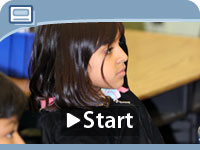
Standards and Planning
Standards guide instruction across all grade levels at Cahuenga Elementary. Hear the perspectives of the principal, coaches, and a teacher about using standards to develop academic English lessons. Review professional development activities for cross-grade teams.
Working as a Team on Standards
Cahuenga’s principal talks about how he and the staff have learned to work together on standards and translate them into daily instruction using simple tools. Review examples from their professional development activities (found below) as you listen. (6:15 min)
Download or View a Video – Quicktime | 50 MB | 6:15 min
Download Transcript & Details – PDF | 144 KB
——————————————————————————–
Everyone’s Role in Academic English
Teachers need instructional support to teach academic English. Listen to Cahuenga’s coaches talk about their roles in supporting teachers to help students develop academic English. (13:38 min)
Download or Play a Video – Quicktime | 103 MB | 13:38 min
Download Transcript & Details – PDF | 172 KB
——————————————————————————–
Sample Materials
Cross-Grade Activity: Vertical Planning
In this session, teachers discuss problems students have with standards in the upper grades and brainstorm instructional ideas that will help teachers in the lower grades better prepare students.
Download Sample | PDF | 340 KB
——————————————————————————–
Teacher-Created Poster Showing Vertical Alignment
Posters created during the professional development session on vertical alignment are a planning resource for teachers.
Download Sample | PDF | 214 KB
——————————————————————————–
Team Activity: Developing Standards-Based Lessons
In this professional development activity, teams of teachers build standards-based writing samples for a range of English Language Development levels.
Download Sample | PDF | 168 KB
Instructional Strategies
Get a glimpse at the instructional strategies used by two schools with a schoolwide emphasis on academic English. See and hear about teachers’ lessons; see student work.
Teaching Academic English to English Learners
This slideshow illustrates some of the practical instructional strategies used at Cahuenga Elementary to teach academic English. Graphic organizers of several types are used schoolwide. You can download an example of a Cahuenga story map in the sample materials section below.
Download Transcript & Details – PDF | 148 KB
——————————————————————————–
Academic English Strategies in the Upper Grades
An upper grades teacher describes instructional activities she does throughout the day, each day, to review language, practice grammar, and build vocabulary. She talks about the relationship between participation in the arts and development of academic English. (2:53 min)
Download Audio – MP3 | 3 MB | 2:53 min
Download Transcript & Details – PDF | 140 KB
——————————————————————————–
Instructional Strategies at Heritage Elementary School
Hear a fourth grade teacher describe how she uses specific strategies to support language development in a unit on Lewis and Clark. She talks about graphic organizers, songs, and deliberate oral language to negotiate meaning. (1:51 min)
Download Audio – MP3 | 2 MB | 1:51 min
Download Transcript & Details – PDF | 124 KB
Sample Materials
——————————————————————————–
Graphic Input Chart for the Lewis and Clark Unit
This chart, referred to in the Heritage interview, not only provides a map of key historical routes but also includes photographs to make the content more accessible.
Download Sample | PDF | 157 KB
——————————————————————————–
Graphic Organizer: Story Map
Graphic maps become more elaborate as students develop in skill or write different types of text. See two stages of a girl’s work on a multi-step story.
Download Sample | PDF | 192 KB
——————————————————————————–
Kindergarten Student Writing Sample: The Butterfly
A kindergarten student writes and illustrates a story about a butterfly.
Download Sample | PDF | 371 KB
Return Links
Return to “DEVELOP ACADEMIC ENGLISH” Page
Return to “PROVIDE READING INTERVENTIONS” Page
Return to “RECOMMENDED PRACTICE” Page
Return to Main Teaching Literacy Page

